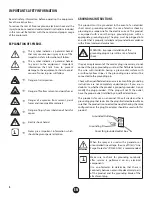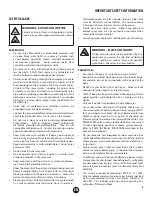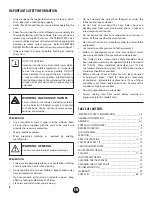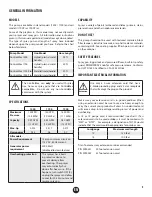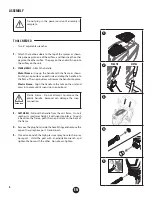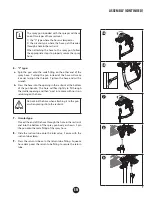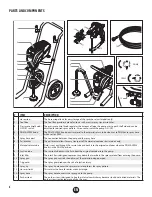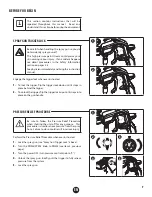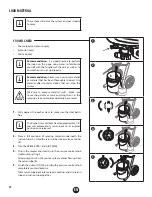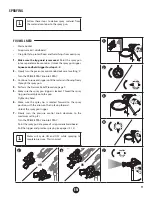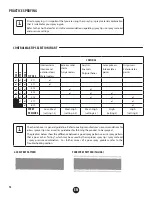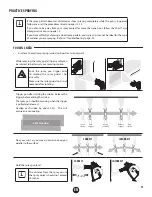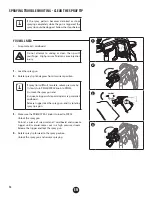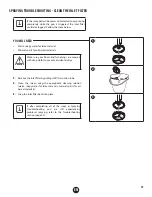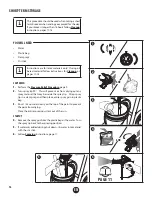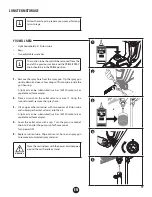
4
EN
IMPORTANT SAFETY INFORMATION
•
Always engage the trigger lock when not spraying. Verify
the trigger lock is functioning properly.
•
Verify that all connections are secure before operating the
unit.
•
Know how to stop the unit and bleed pressure quickly. Be
thoroughly familiar with the controls. Pressure will not be
released by turning off the motor. The PRIME/SPRAY valve
or pressure bleed valve must be turned to their appropriate
positions to relieve system pressure. Refer to PRESSURE
RELIEF PROCEDURE described in the pump manual (page 9).
•
Always remove the spray tip before flushing or cleaning
the system.
i
NOTE TO PHYSICIAN:
Injection into the skin is a traumatic injury which
can lead to possible amputation. It is important
to treat the injury as soon as possible. DO NOT
delay treatment to research toxicity. Toxicity is
a concern with some coatings injected directly
into the blood stream. Consultation with a plastic
surgeon or reconstructive hand surgeon may be
advisable.
warning: HaZarDOuS VaPOrS
Paints, solvents, insecticides, and other materials
can be harmful if inhaled or come in contact
with the body. Vapors can cause severe nausea,
fainting, or poisoning.
PrEVEnTiOn:
•
Use a respirator or mask if vapors can be inhaled. Read
all instructions supplied with the mask to be sure it will
provide the necessary protection.
•
Wear protective eyewear.
•
Wear protective clothing as required by coating
manufacturer.
warning: gEnEraL
Can cause severe injury or property damage.
PrEVEnTiOn:
•
Always wear appropriate gloves, eye protection, clothing
and a respirator or mask when painting.
•
Do not operate or spray near children. Keep children away
from equipment at all times.
•
Do not overreach or stand on an unstable support. Keep
effective footing and balance at all times.
•
Stay alert and watch what you are doing.
•
Do not operate the unit when fatigued or under the
influence of drugs or alcohol.
•
Do not kink or over-bend the hose. Airless hose can
develop leaks from wear, kinking and abuse. A leak can
inject material into the skin.
•
Do not expose the hose to temperatures or pressures in
excess of those specified by manufacturer.
•
Do not use the hose as a strength member to pull or lift the
equipment.
•
Use lowest possible pressure to flush equipment.
•
Follow all appropriate local, state and national codes
governing ventilation, fire prevention and operation.
•
The United States Government Safety Standards have
been adopted under the Occupational Safety and Health
Act (OSHA). These standards, particularly part 1910 of
the General Standards and part 1926 of the Construction
Standards should be consulted.
•
Before each use, check all hoses for cuts, leaks, abrasion
or bulging of cover. Check for damage or movement
of couplings. Immediately replace hose if any of those
conditions exist. Never repair a paint hose. Replace with a
conductive high-pressure hose.
•
Do not spray outdoors on windy days.
•
Always unplug cord from outlet before working on
equipment (electric models only).
TABLE OF CONTENTS
IMPORTANT SAFETY INFORMATION __________________ 2-4
GENERAL INFORMATION _____________________________ 5
ASSEMBLY _______________________________________ 6-7
PARTS AND COMPONENTS ___________________________ 8
BEFORE YOU BEGIN _________________________________ 9
LOAD MATERIAL ___________________________________ 10
SPRAYING ________________________________________ 11
PRACTICE SPRAYING ____________________________ 12-13
CLEAR THE SPRAY TIP _______________________________ 14
CLEAN THE INLET FILTER ____________________________ 15
SHORT TERM STORAGE _____________________________ 16
CLEANUP ______________________________________ 17-18
LONG TERM STORAGE ______________________________ 19
CLEANING THE INLET VALVE _________________________ 20
CLEANING THE OUTLET VALVE _______________________ 21
TROUBLESHOOTING ________________________________ 22
WARRANTY _______________________________________ 23
PARTS LIST ____________________________________ 68-72


